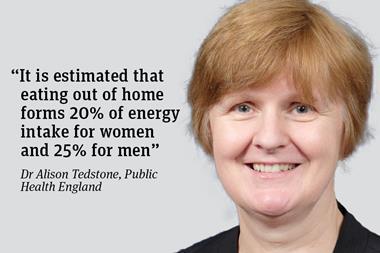
Public Health England today set out targets for the industry to remove 200,000 tonnes of sugar per year from the UK diet by 2020.
As well as calling on manufacturers and retailers to shrink thousands of products, including chocolate bars, ice creams and yoghurts, it urged reformulation and a switch towards changing the emphasis in product lineups to more healthy products.
Here is how the industry, the health lobby and other experts reacted.
Tam Fry, spokesman for the National Obesity Forum:
“Simply downsizing sugary food is not the answer. Of the four options given to industry to remove 20% of sugar from their products, downsizing runs the real risk that people will buy two of whatever the product is and eat substantially more.
“The preferred option is to reformulate the entire product and replace sugar with other ingredients.”
Andrea Martinez-Inchausti, deputy director of food policy at the BRC:
“UK retailers and BRC out of home members have long demonstrated their commitment to tackling childhood obesity and have led the way in reformulating products. They remain fully committed and supportive of the government ambition to reduce sugar consumption and welcome the publication of today’s report.
“Significant progress has already been made but the complexity of the reformulation process gives us concern about the timescales. Furthermore, to achieve the objective as outlined by PHE, these targets need to create a level playing field for every food company, large or small, to commit to and address.”
Ian Wright, director general of the FDF:
“Obesity levels in the UK are unacceptably high. Physical inactivity is a factor, but for many the problem overwhelmingly is with excess calories in the diet. With many of these calories coming from sugars, we support the government’s highly ambitious sugars reduction drive.
“Today’s report represents a constructive platform on which to build a world-leading programme of voluntary sugars reduction, right across food and drink. All parts of the food industry - manufacturers, retailers, takeaways, restaurants and cafés - need to step up. The guidelines are very stretching but manufacturers, for our part, are willing to take on the challenge.
“Manufacturers know the special place their products have in people’s lives. Companies are working hard to overcome technical challenges and make gradual tweaks to favourite foods that regular customers can accept. They are also developing new low-sugar alternatives. In some foods, portion size reductions will be necessary.
“This programme is only one piece of a much wider jigsaw of work that needs to be done to move towards better overall diets and more active lifestyles. We look forward to continuing to work closely with PHE and other partners as the programme moves from design into implementation.”
Graham MacGregor, chairman of Action on Sugar:
“We congratulate PHE’s tremendous achievement on getting coherent and achievable sugar reduction targets in such a short space of time. However, the missing factor in this report is how these targets will be enforced.
“We’ve seen over recent weeks that some companies within the food and drink industry have made great progress whilst others are seriously lagging behind and others claiming wrongly that they can’t do it. Doing nothing is no longer an option - we need transparency from them about how they are meeting the targets (with clear nutritional information made available for restaurants, catering companies and other out-of-home eateries). If these recalcitrant companies don’t comply we need Theresa May to bring in tough measures to ensure compliance and put public health first before the profits of the food industry.”
Judy Buttriss, director general of the British Nutrition Foundation:
“The new government recommendation to reduce our intake of free sugars to less than 5% of food energy is very challenging and action across all sectors, including out of home food outlets, is going to be key to any success.
“Some companies have already made significant changes to the sugar and calorie content of their products and there have been some encouraging announcements of plans by industry to step up to the challenge, but there is more to be done.
“This includes promoting the idea that smaller portions are a positive step to reduce our energy intakes and contribute to the fight against the obesity problem we face in Britain.”
Sue Kellie, deputy chief executive of the British Dietetic Association:
“The BDA believes that the government now needs to commit to further action in areas such as advertising and promotions.
“Reducing the sugar in foods is certainly one way to tackle obesity, but behaviours need to change as well. The BDA would suggest that, whilst there are new tougher advertising guidelines on non-broadcasting media, this does not go far enough. The government needs to further restrict the advertising of HFSS foods before the 9pm watershed and ban promotions on those same products.”
Kathy Groves, head of microscopy, Leatherhead Food Research:
“The PHE guidelines refer to the use of sweeteners approved by the European Food Safety Authority as an alternative to sugar. There are many sugar replacement options available, both natural and artificial. However, food manufacturers need to be mindful that their use does not necessarily reduce overall calories. Sugar alternatives - broadly classified as bulk sweeteners or intense sweeteners - can reduce calorie count, but they are considered additives, so compromise clean label classification. Blueprinting provides a scientific framework for testing various approaches to the reduction or replacement of sugar, assessing how they impact attributes such as calorie count, sensory characteristics and shelf-life.”



















No comments yet